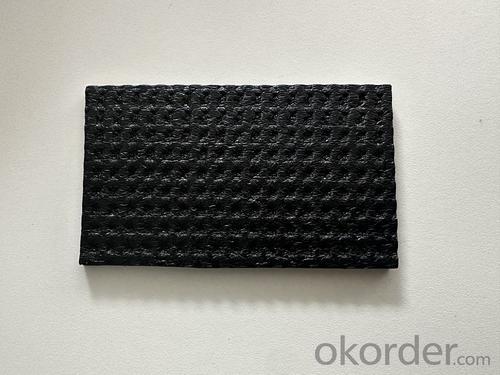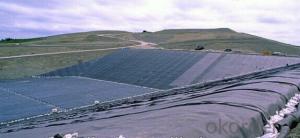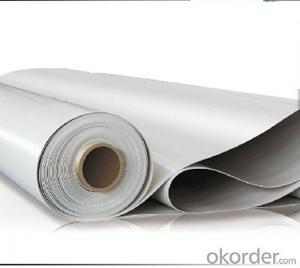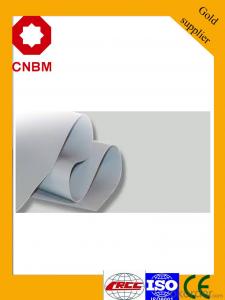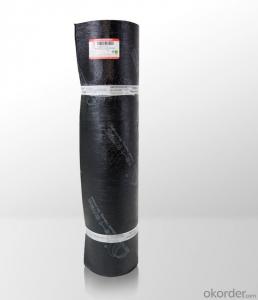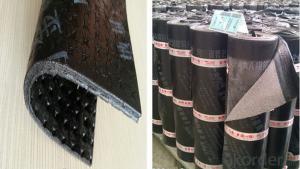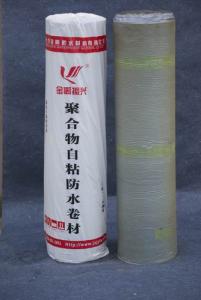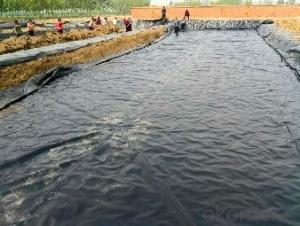Polymer(SBS)modified bituminous waterproofing sheet of resistance to root penetration
- Loading Port:
- China main port
- Payment Terms:
- TT OR LC
- Min Order Qty:
- 10 m²
- Supply Capability:
- 800000 m²/month
OKorder Service Pledge
OKorder Financial Service
You Might Also Like
Specification
01 Product introduction Product Introduction
Jiuyang waterproof polymer modified asphalt root puncture waterproof reel is made of long fiber polyester felt or special composite copper tire base as the reel tire base, SBS modified asphalt with imported chemical root blocking agent as the coating material, and polyethylene film, fine sand or mineral particles as the isolation material on both sides. It has good puncture resistance, strong adhesion, good stability, low temperature flexibility and good heat resistance, reflecting excellent resistance and waterproof performance.
02 Product characteristics
1. It has the dual function of waterproof and preventing plant root penetration, and can withstand plant root puncture and maintain waterproof function for a long time.
2. It prevents root puncture and does not affect the normal growth of plants.
3. It can form a high-strength waterproof layer, strong resistance to water pressure, and resistant to puncture, rupture and tear.
4. High tensile strength, large thickness of modified asphalt coating layer, strong adaptability to base shrinkage deformation and cracking.
5. Excellent high and low temperature resistance, suitable for both hot and cold areas.
6. Corrosion resistance, mold resistance, good weather resistance.
7. Hot melt construction, convenient construction and hot joint reliable and durable.
03 Applicable scope
Suitable for planting roofs and the roof of underground buildings that need greening, the plant root puncture resistant layer ensures that the plant root system does not damage the structure below this level, and has waterproof function.
04 Packaging and storage andtransportation
1. When storing and transporting, different types and specifications of products should be stacked separately and should not be mixed. Avoid sun and rain, pay attention to ventilation, away from fire.
2. Storage temperature should not be higher than 50℃, vertical storage can only be single layer, and neutral storage should not exceed two layers during transportation.
3. Prevent tilt or side pressure during transportation, and cover the tarpaulin if necessary.
4. Under normal transportation and storage conditions, the storage period is 1 year from the date of production.
- Q: Can a waterproofing membrane be used in temporary or temporary structures?
- Yes, a waterproofing membrane can be used in temporary or temporary structures. Waterproofing membranes are designed to provide a protective barrier against water penetration, which is essential in preventing moisture damage in any type of building structure. Whether it is a permanent or temporary structure, such as a temporary shelter, tent, or temporary construction site, a waterproofing membrane can be applied to ensure water resistance and protection. It is important to choose a waterproofing membrane that is suitable for the specific needs of the temporary structure and follow proper installation guidelines to ensure its effectiveness.
- Q: Can a waterproofing membrane be applied to both interior and exterior surfaces?
- Yes, a waterproofing membrane can be applied to both interior and exterior surfaces.
- Q: How does a waterproofing membrane handle differential settlement?
- The purpose of a waterproofing membrane is to prevent water infiltration and protect the underlying structure from moisture damage. However, the performance of the membrane can be affected when dealing with differential settlement. Differential settlement refers to uneven settling of the ground or building foundation, which can result in variations in height or level within the structure. This can cause stress and movement in the building, potentially impacting the waterproofing membrane. To address differential settlement, waterproofing membranes are designed to be flexible and capable of accommodating minor movements without compromising their effectiveness. They are often made from materials like modified bitumen, polyurethane, or rubberized asphalt, which have inherent elasticity and can stretch or contract to a certain degree. In cases of minor differential settlement within the membrane's tolerances, it can adjust and remain intact, maintaining its waterproofing capabilities. However, significant settlement or movement beyond the membrane's flexibility may cause cracks or tears, leading to potential water leakage. To minimize the impact of differential settlement, additional measures can be taken during membrane installation. This may involve incorporating stress-relieving elements like expansion joints or utilizing specialized installation techniques that allow for movement. These measures help distribute the stress caused by settlement and reduce strain on the waterproofing membrane. It is important to note that while waterproofing membranes can handle some level of differential settlement, they are not a solution for structural issues or significant settlement problems. In cases of severe settlement, it is crucial to address the underlying cause and potentially involve a structural engineer to determine appropriate remediation measures. In conclusion, a waterproofing membrane can accommodate minor movements caused by differential settlement through its flexibility. However, considering the severity of settlement and implementing additional measures during installation is crucial for ensuring the long-term effectiveness of the waterproofing system.
- Q: Can a waterproofing membrane be used on precast chrome surfaces?
- Yes, a waterproofing membrane can be used on precast chrome surfaces. The membrane will provide a protective barrier against water penetration, ensuring the durability and longevity of the precast chrome surfaces.
- Q: Can a waterproofing membrane be used for a shower pan liner installation?
- Yes, a waterproofing membrane can be used for a shower pan liner installation. Waterproofing membranes are commonly used in shower installations to prevent water from seeping through the shower pan and causing damage to the surrounding areas. They provide an effective barrier against moisture and help to keep the shower area waterproof.
- Q: How long does a waterproofing membrane typically last?
- The lifespan of a waterproofing membrane can differ based on various factors like the type and quality of the membrane, how it is installed, environmental conditions, and how well it is maintained. However, on average, a properly installed and well-maintained waterproofing membrane can endure for approximately 10 to 20 years. Some high-quality membranes may even last longer, up to 30 years or more. It is essential to note that regular maintenance, including inspections and necessary repairs, can significantly prolong the lifespan of a waterproofing membrane. Furthermore, factors such as exposure to harsh weather conditions, ultraviolet (UV) radiation, chemicals, and foot traffic can impact the durability of the membrane and may necessitate more frequent maintenance or replacement. To ensure the long-lasting performance of a waterproofing membrane, it is advisable to adhere to the manufacturer's guidelines for installation, maintenance, and repair. It is crucial to conduct regular inspections, particularly after severe weather events or significant changes in the surrounding structures, to promptly identify and address any potential issues. By properly caring for the waterproofing membrane, you can maximize its lifespan and safeguard the underlying structure against water damage.
- Q: Can a waterproofing membrane be applied to tiled surfaces?
- Yes, a waterproofing membrane can be applied to tiled surfaces. The membrane is typically installed underneath the tiles to provide an additional layer of protection against water damage.
- Q: Can a waterproofing membrane be used on concrete block surfaces?
- Yes, a waterproofing membrane can be used on concrete block surfaces. Waterproofing membranes are designed to provide a barrier against moisture and water penetration, and they are commonly used on concrete block surfaces to protect against water damage and leaks. These membranes are typically applied as a liquid or sheet material and adhere to the surface of the concrete blocks, creating a protective layer that prevents water from seeping through. The waterproofing membrane helps to extend the lifespan of the concrete blocks by reducing the risk of water damage, mold growth, and deterioration. It is important to choose a waterproofing membrane that is specifically designed for concrete block surfaces and follow the manufacturer's instructions for proper installation to ensure the best results.
- Q: Can a waterproofing membrane prevent leaks from occurring?
- Preventing leaks is indeed possible with the use of a waterproofing membrane. This membrane is a thin material layer that, when applied to a surface, renders it completely impervious to water. Its purpose is to serve as a barrier, effectively stopping water from seeping through and causing any leaks. With correct installation and ongoing maintenance, a waterproofing membrane can provide reliable protection against water damage for a variety of structures, such as roofs, basements, bathrooms, and foundations. It is specifically designed to withstand the forces of nature, including rain, snow, and moisture, thus greatly reducing the likelihood of leaks and water infiltration. However, it is worth noting that the efficacy of a waterproofing membrane also relies on the quality of the product, proper installation procedures, and regular maintenance.
- Q: Can a waterproofing membrane be used for roofing applications?
- Indeed, a waterproofing membrane can be utilized in roofing applications. Specifically designed to create a barrier against water infiltration, waterproofing membranes are commonly employed in a range of construction projects, including roofs. These membranes typically consist of durable materials like synthetic rubber, thermoplastics, or modified bitumen, renowned for their water-resistant properties and longevity. By installing a waterproofing membrane on the roof, one can effectively safeguard the building from water leaks and moisture penetration, which may result in structural damage, mold growth, and other related problems. The membrane is typically applied seamlessly onto the roof surface, forming a watertight layer that prevents water from permeating through. Waterproofing membranes for roofing applications are available in various types, such as sheet membranes, liquid or spray-applied membranes, or self-adhering membranes. Each type offers distinct advantages and suitability depending on the specific roofing requirements and construction conditions. In conclusion, a waterproofing membrane is indeed a viable choice for roofing applications, providing an efficient solution to ensure a durable and watertight roof system.
Send your message to us
Polymer(SBS)modified bituminous waterproofing sheet of resistance to root penetration
- Loading Port:
- China main port
- Payment Terms:
- TT OR LC
- Min Order Qty:
- 10 m²
- Supply Capability:
- 800000 m²/month
OKorder Service Pledge
OKorder Financial Service
Similar products
Hot products
Hot Searches
Related keywords


